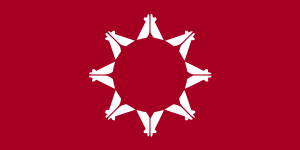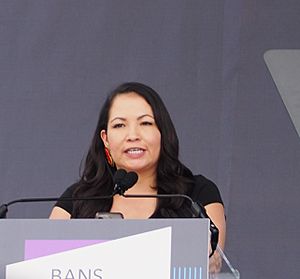Oglala facts for kids
| Oglála Lakhóta Oyáte | |
|---|---|
 |
|
| Total population | |
| 46,855 enrolled tribal members (2013) | |
| Regions with significant populations | |
| Languages | |
| Lakota, English | |
| Religion | |
| Traditional tribal religion, Sun Dance, Native American Church, Christianity |
|
| Related ethnic groups | |
| other Lakota peoples, Dakota, Nakota |
The Oglala are a special group of people who are part of the larger Lakota people. The name "Oglala" means "to scatter one's own," which tells a bit about their history. The Lakota, along with the Dakota, form a big family of tribes called the Očhéthi Šakówiŋ, or "Seven Council Fires." Most Oglala people today live on the Pine Ridge Indian Reservation in South Dakota, which is one of the largest Native American reservations in the United States.
The Oglala are officially recognized as a tribe by the U.S. government. Their full name is the Oglala Sioux Tribe of the Pine Ridge Reservation, South Dakota. They have a rich history and culture that they continue to share and celebrate.
Contents
Discovering Oglala History
Oglala elders, who are respected older members of the community, share stories about how their group first came to be. These stories suggest that the Oglala became a distinct group sometime in the 1700s.
Early Interactions with Newcomers
In the early 1800s, more and more European and American travelers began to pass through the lands where the Lakota lived. These newcomers were often looking for animal furs, like those from beavers and later bison. This fur trade brought changes to the Oglala's way of life and their economy.
Treaties and Land Changes
In 1868, the United States government and the Great Sioux Nation signed an important agreement called the Fort Laramie Treaty. This treaty led to some Oglala lands and rights being given to the United States. In return, the Oglala received food and other supplies from the U.S. government.
This period was challenging for the Oglala. Some groups chose to work with the government agencies that provided food and supplies. Other groups wanted to keep their traditional ways of life. Many Oglala families moved between these two choices, sometimes visiting the agencies in winter and joining relatives in the north during spring. These changes caused different Oglala groups to make their own decisions about how to adapt.
Life on the Reservation
The large Great Sioux Reservation was later divided into smaller areas. Because of this, the Red Cloud Agency, which helped the Oglala, moved several times. Finally, in 1878, it settled and became known as the Pine Ridge Reservation. By 1890, about 5,537 Oglala people lived on the reservation, spread across many communities.
Oglala Community Life
A respected Oglala elder named Left Heron once explained the deep importance of community. He said that before the arrival of the White Buffalo Calf Woman, people lived without a strong sense of togetherness. The White Buffalo Calf Woman not only brought the Sacred Pipe to the tribe but also taught the Lakota people about the importance of family (tiwahe) and community (tiyospaye).
These two values became very important. As the Dakota anthropologist Ella Cara Deloria said, everything else, like property or personal goals, came second to promoting family and community. This strong connection between related families has always been a key part of Oglala history.
Understanding Oglala Communities (Tiyóšpaye)
In 1875, a U.S. official named Dr. John J. Saville noted that the Oglala tribe had three main groups: the Kiyuksa, the Oyuĥpe, and the True Oglala. Each of these larger groups was then divided into smaller parties, often named after their chief or leader. When the Oglala settled on the Pine Ridge Reservation in the late 1870s, their communities were organized like this:
Oyuȟpe Tiyóšpaye
- True Oyuȟpe (led by Big Road)
- Wakaŋ
- Makaicu (led by Red Dog)
Oglala Tiyóšpaye
- True Oglala
- Caŋkahuȟaŋ (led by He Dog)
- Hokayuta (led by Black Twin)
- Huŋkpatila (led by Little Hawk and Crazy Horse)
- Ité šíčA (led by Red Cloud)
- Payabya (led by They Even Fear His Horses)
- Wágluȟe (led by Chief Blue Horse, American Horse, and Three Bear)
Kiyaksa Tiyóšpaye
- True Kiyaksa
- Kuinyan (led by Little Wound)
- Tapišleca (led by Yellow Bear)
Oglala Population Over Time
By 1830, there were about 3,000 Oglala people. In the 1820s and 1830s, the Oglala joined with the Brulé (another Lakota group) and three other Sioux bands. Together, they formed the Sioux Alliance. This alliance worked together to protect their lands and hunting areas from other tribes.
Oglala Culture and Traditions
Roles in the Community
Historically, women played a very important role in family and tribal life. They made almost everything the family and tribe used. This included growing and preparing crops, cooking food, preparing game and fish, and working with animal skins. From these skins, they made clothing, footwear, storage bags, and even the coverings for their tipis (homes). Women traditionally managed the food, resources, and movable property, and they owned the family's home.
In Oglala Lakota society, men traditionally took charge of tribal politics. Men often served as chiefs for political matters, led in times of war, were warriors, and hunted for the community. When a man married, he would typically go to live with his wife's family.
The Oglala Flag
The Oglala flag has a red background. This red color represents the courage and strength of the Sioux people in protecting their lands. In the center, there is a circle of eight white tipis. The tops of the tipis point outwards. These eight tipis stand for the eight different districts of the Pine Ridge Reservation: Porcupine, Wakpammi, Medicine Root, Pass Creek, Eagle Nest, White Clay, LaCreek, and Wounded Knee.
The flag was first shown during the Sun Dance ceremonies in 1961. It was officially adopted on March 9, 1962. Over time, this flag has become very well-known. It is often seen at Native American gatherings called powwows, not just those of the Sioux. Sometimes, it is even flown as a general symbol for all Native American people.
The flag shown here is the original design.
Famous Oglala People
Many Oglala individuals have made important contributions in various fields.
Leaders and Influencers
- American Horse (The Younger)
- American Horse (The Elder)
- Crazy Horse
- Red Cloud
- Black Elk
- Russell Means (Oyate Wacinyapin)
Military Heroes
- Ola Mildred Rexroat – She was the only Native American pilot in the Women Airforce Service Pilots (WASP) during World War II.
Talented Artists
- Arthur Amiotte, a mixed-media artist.
- Mo Brings Plenty, a TV actor known for the show Yellowstone.
Inspiring Athletes
- Billy Mills, an Olympic champion who won a gold medal in the 10,000-meter race at the 1964 Summer Olympics.
- Teton Saltes, a professional football player.
Storytellers and Performers
- Albert White Hat, a respected storyteller.
- Albert Afraid of Hawk – a member of Buffalo Bill's Wild West Show. His remains were returned to the Pine Ridge Reservation in 2012.
Culinary Innovators
- Sean Sherman, a chef and co-author of The Sioux Chef's Indigenous Kitchen, who focuses on Indigenous foods.
See also
 In Spanish: Siux oglala para niños
In Spanish: Siux oglala para niños
- Sicaŋǧu, also known as Brulé (Burned Thighs)
- Itazipco, also known as Sans Arc (No Bows)
- Huŋkpapa (End of Village)
- Miniconjou (Swamp Plant)
- Sihasapa (Blackfoot Sioux)
- O'ohenuŋpa (Two Kettles)



